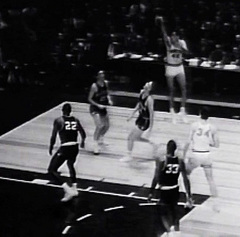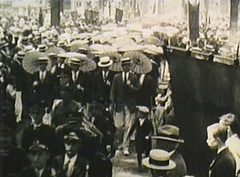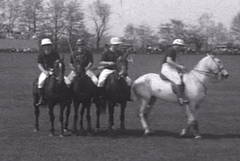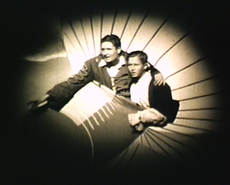In the 1946-1947 academic year, Princeton celebrated its 200th anniversary with a series of convocations and events, ending with a concluding ceremony, captured in a newsreel, which included a convocation address by US President Harry Truman. Today’s blog features another newsreel about the University’s bicentennial year that focuses on “Charter Day,” October 19, 1946. In addition to Princeton’s almost 200-year old charter and the “largest procession in Princeton history” at the time (which included 23 honorary degrees recipients), the newsreel addresses the beginning of intercollegiate football, depicting a re-enactment of the first football game between Princeton and Rutgers from November 6, 1869 during halftime of the 1946 Princeton-Rutgers game.
Princeton’s charter, granted to the University on October 22, 1746 (then still known as the “College of New Jersey”) is shown fleetingly in the newsreel (0:38). Readers of our regular blog already know that the charter, on intermittent display during the celebration of Mudd Manuscript Library’s 50th anniversary, is actually not the original (which was lost) but the second charter, drawn up in 1748. (An explanation can be found in our Frequently Asked Questions.) The famous early picture of Nassau Hall that follows at 0:48 is the copper engraving by Philadelphia artist Henry Dawkins (copied from a drawing by Princeton student William Tennent, Class of 1758), which was printed in Samuel Blair’s Account of the College of New Jersey (1764). For more information about the engraver, who was also a counterfeiter of paper money, see Julie Mellby’s Graphic Arts blog.
Over 500 people comprised the academic procession that opened and closed the morning’s convocation, according to the Prince, including faculty, trustees, representatives of all alumni classes and members of the Undergraduate Council. The procession included an official delegation from the United Nations, headed by Secretary General Trygve Lie, and members from the State Bicentennial Commission, including Walter E. Edge, Governor of New Jersey. Lie (1:42) and Edge (2:11) were among the 23 honorary degree recipients, as were the Danish physicist Niels Bohr, the Spanish writer Salvador De Madariaga, and the French philosopher Jacques Maritain (2:21–not all recipients are clearly visible).
The last eight minutes of the newsreel are occupied by the 38th Rutgers-Princeton football game in the afternoon (2:47), with a humorous reenactment of the first Rutgers-Princeton game of November 6, 1869 (5:51), considered the ‘birth’ of intercollegiate football. A description of the football game and the reenactment by Theatre Intime and members of the Rutgers soccer team can be found in the Prince. A copy of the program notes about the 1869 football game, with an explanation of the rules, may be downloaded at Twenty-four Stalwart Men.pdf. A second article from the program, summarizing the history of the Princeton-Rutgers football rivalry, can be viewed at 77 Years Princeton-Rutgers.pdf. More information about early football can be found in Football: the Ivy League Origins of an American Obsession by Mark Bernstein ’83, who wrote our previous blog entry.
The footage on this 16mm film is part of the University Archives’ Historical Audiovisual Collection (part of item no. 0092).








